Gene Therapy for Hemophilia: Current and Emerging Therapies Essay
VerifiedAdded on 2023/01/23
|7
|1143
|86
Essay
AI Summary
This essay provides an overview of gene therapy, focusing on its application in treating hemophilia. It begins with an introduction to gene therapy and its objective of correcting or adding gene expression to treat diseases. The essay then delves into the use of adeno-associated virus (AAV) gene therapy for hemophilia, detailing the disease's characteristics, the role of the FVIII gene, and the advantages and disadvantages of AAV vectors. The essay also explores current and emerging gene therapies, including clinical trials using codon-optimized versions of the human factor VIII gene and the impact of these therapies on bleeding reduction and the cessation of prophylactic treatments. The conclusion emphasizes the safety and efficacy of gene therapy for hemophilia, the use of non-integrating AAV vectors, and the potential benefits for resource-poor countries. The essay concludes by highlighting the improvement in the quality of life for individuals with hemophilia.
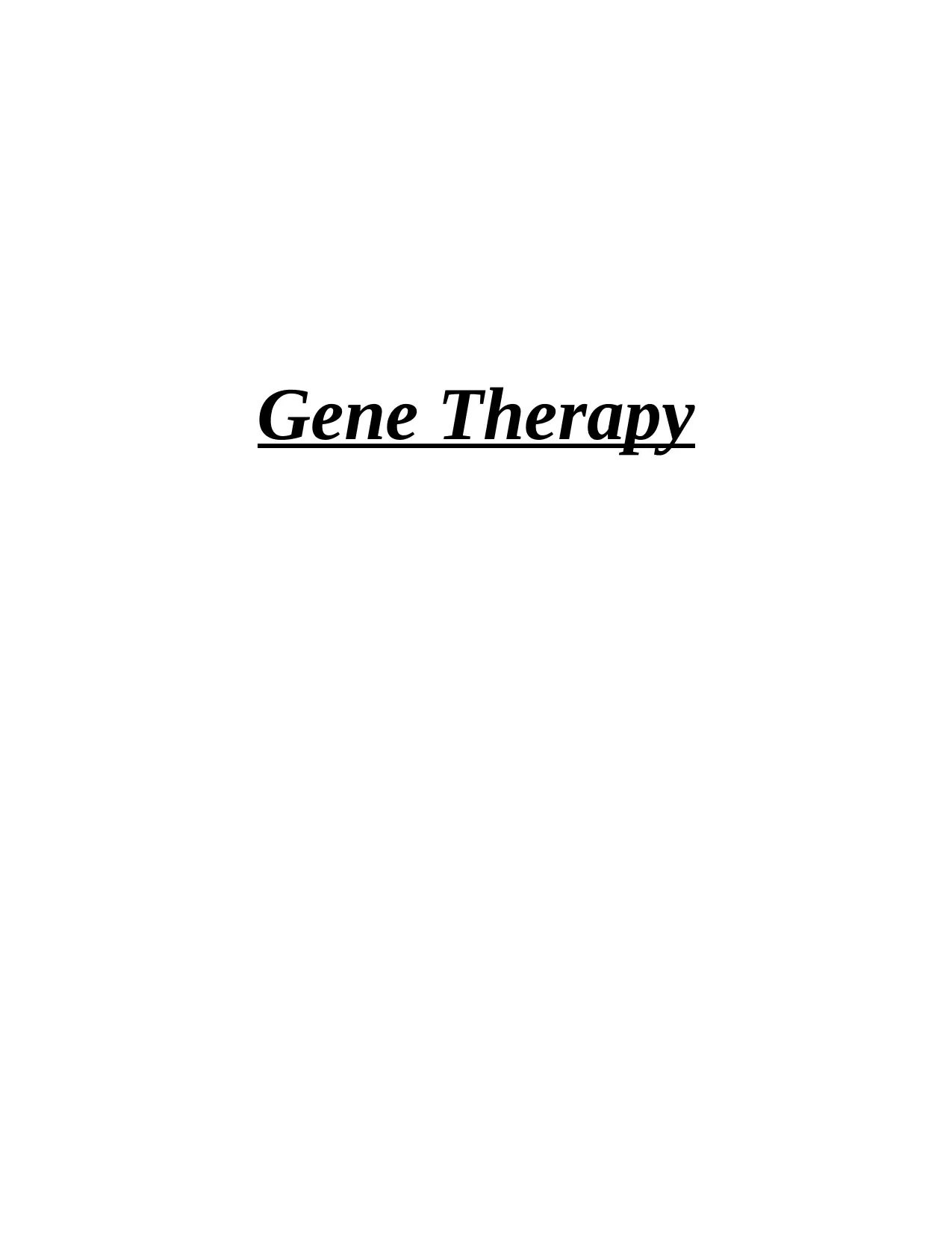
Gene Therapy
Paraphrase This Document
Need a fresh take? Get an instant paraphrase of this document with our AI Paraphraser

Table of Contents
INTRODUCTION...........................................................................................................................1
Adeno associated virus gene therapy of haemophilia disease................................................1
Current and emerging gene therapies.....................................................................................2
CONCLUSION................................................................................................................................2
REFERENCES................................................................................................................................4
INTRODUCTION...........................................................................................................................1
Adeno associated virus gene therapy of haemophilia disease................................................1
Current and emerging gene therapies.....................................................................................2
CONCLUSION................................................................................................................................2
REFERENCES................................................................................................................................4

⊘ This is a preview!⊘
Do you want full access?
Subscribe today to unlock all pages.

Trusted by 1+ million students worldwide
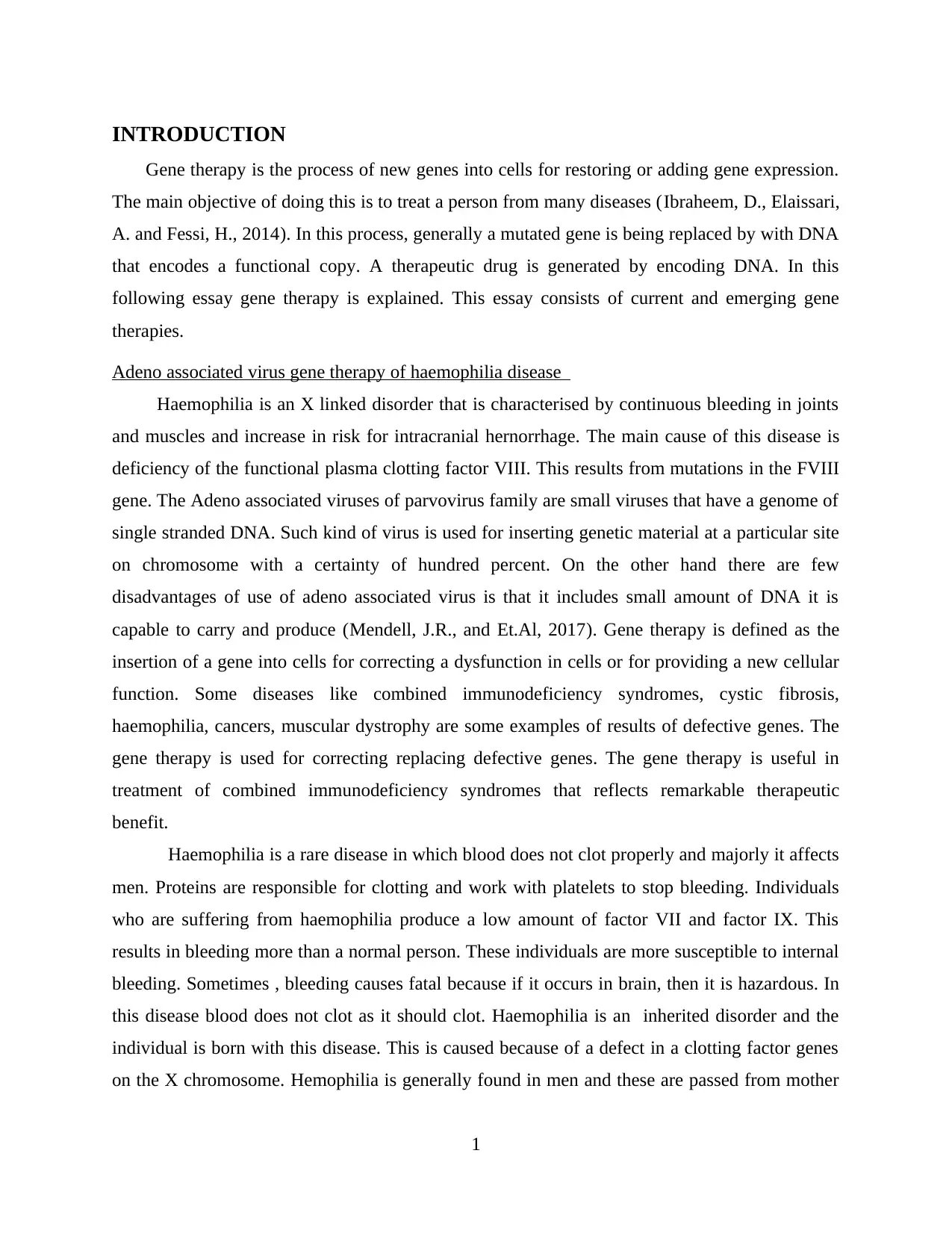
INTRODUCTION
Gene therapy is the process of new genes into cells for restoring or adding gene expression.
The main objective of doing this is to treat a person from many diseases (Ibraheem, D., Elaissari,
A. and Fessi, H., 2014). In this process, generally a mutated gene is being replaced by with DNA
that encodes a functional copy. A therapeutic drug is generated by encoding DNA. In this
following essay gene therapy is explained. This essay consists of current and emerging gene
therapies.
Adeno associated virus gene therapy of haemophilia disease
Haemophilia is an X linked disorder that is characterised by continuous bleeding in joints
and muscles and increase in risk for intracranial hernorrhage. The main cause of this disease is
deficiency of the functional plasma clotting factor VIII. This results from mutations in the FVIII
gene. The Adeno associated viruses of parvovirus family are small viruses that have a genome of
single stranded DNA. Such kind of virus is used for inserting genetic material at a particular site
on chromosome with a certainty of hundred percent. On the other hand there are few
disadvantages of use of adeno associated virus is that it includes small amount of DNA it is
capable to carry and produce (Mendell, J.R., and Et.Al, 2017). Gene therapy is defined as the
insertion of a gene into cells for correcting a dysfunction in cells or for providing a new cellular
function. Some diseases like combined immunodeficiency syndromes, cystic fibrosis,
haemophilia, cancers, muscular dystrophy are some examples of results of defective genes. The
gene therapy is used for correcting replacing defective genes. The gene therapy is useful in
treatment of combined immunodeficiency syndromes that reflects remarkable therapeutic
benefit.
Haemophilia is a rare disease in which blood does not clot properly and majorly it affects
men. Proteins are responsible for clotting and work with platelets to stop bleeding. Individuals
who are suffering from haemophilia produce a low amount of factor VII and factor IX. This
results in bleeding more than a normal person. These individuals are more susceptible to internal
bleeding. Sometimes , bleeding causes fatal because if it occurs in brain, then it is hazardous. In
this disease blood does not clot as it should clot. Haemophilia is an inherited disorder and the
individual is born with this disease. This is caused because of a defect in a clotting factor genes
on the X chromosome. Hemophilia is generally found in men and these are passed from mother
1
Gene therapy is the process of new genes into cells for restoring or adding gene expression.
The main objective of doing this is to treat a person from many diseases (Ibraheem, D., Elaissari,
A. and Fessi, H., 2014). In this process, generally a mutated gene is being replaced by with DNA
that encodes a functional copy. A therapeutic drug is generated by encoding DNA. In this
following essay gene therapy is explained. This essay consists of current and emerging gene
therapies.
Adeno associated virus gene therapy of haemophilia disease
Haemophilia is an X linked disorder that is characterised by continuous bleeding in joints
and muscles and increase in risk for intracranial hernorrhage. The main cause of this disease is
deficiency of the functional plasma clotting factor VIII. This results from mutations in the FVIII
gene. The Adeno associated viruses of parvovirus family are small viruses that have a genome of
single stranded DNA. Such kind of virus is used for inserting genetic material at a particular site
on chromosome with a certainty of hundred percent. On the other hand there are few
disadvantages of use of adeno associated virus is that it includes small amount of DNA it is
capable to carry and produce (Mendell, J.R., and Et.Al, 2017). Gene therapy is defined as the
insertion of a gene into cells for correcting a dysfunction in cells or for providing a new cellular
function. Some diseases like combined immunodeficiency syndromes, cystic fibrosis,
haemophilia, cancers, muscular dystrophy are some examples of results of defective genes. The
gene therapy is used for correcting replacing defective genes. The gene therapy is useful in
treatment of combined immunodeficiency syndromes that reflects remarkable therapeutic
benefit.
Haemophilia is a rare disease in which blood does not clot properly and majorly it affects
men. Proteins are responsible for clotting and work with platelets to stop bleeding. Individuals
who are suffering from haemophilia produce a low amount of factor VII and factor IX. This
results in bleeding more than a normal person. These individuals are more susceptible to internal
bleeding. Sometimes , bleeding causes fatal because if it occurs in brain, then it is hazardous. In
this disease blood does not clot as it should clot. Haemophilia is an inherited disorder and the
individual is born with this disease. This is caused because of a defect in a clotting factor genes
on the X chromosome. Hemophilia is generally found in men and these are passed from mother
1
Paraphrase This Document
Need a fresh take? Get an instant paraphrase of this document with our AI Paraphraser
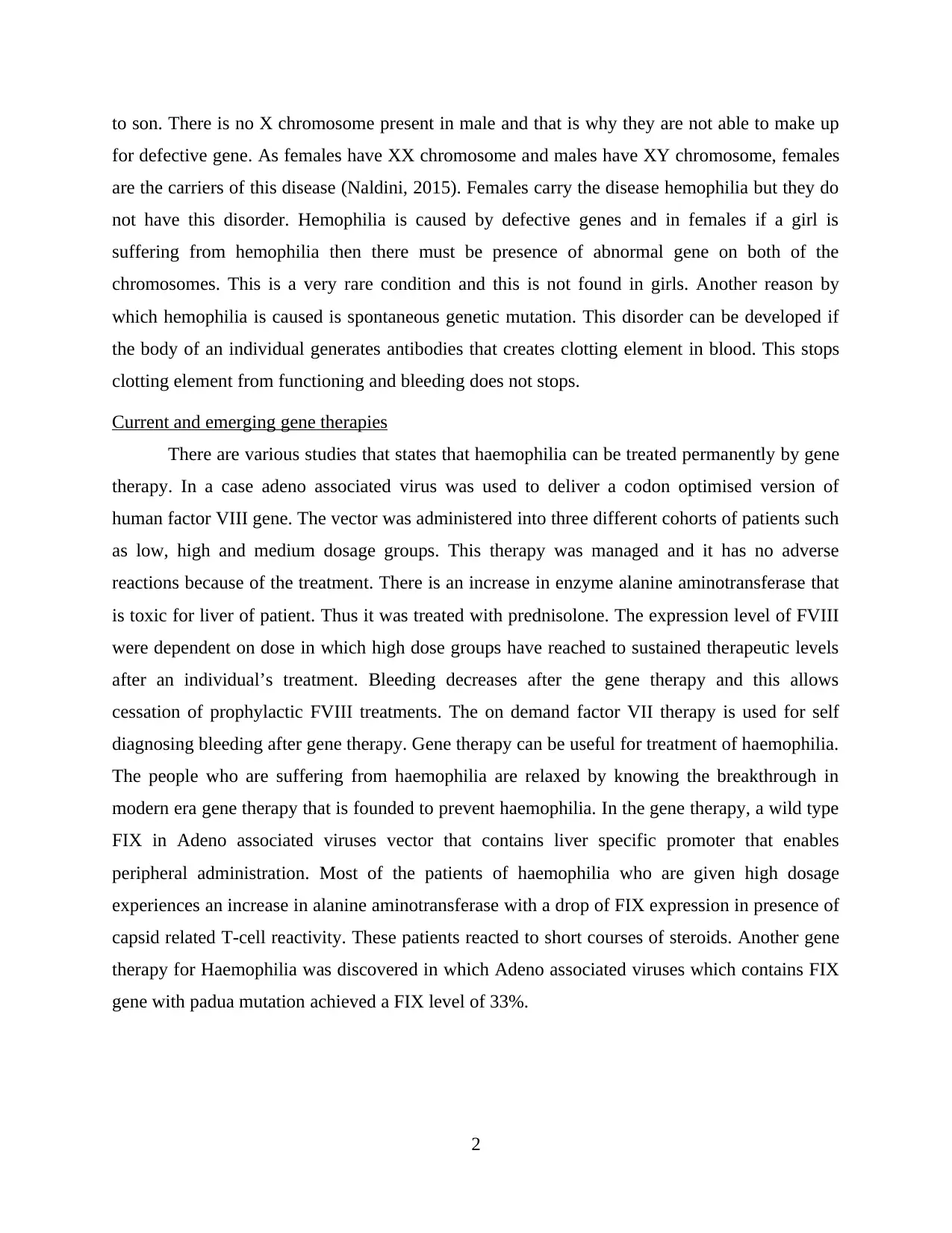
to son. There is no X chromosome present in male and that is why they are not able to make up
for defective gene. As females have XX chromosome and males have XY chromosome, females
are the carriers of this disease (Naldini, 2015). Females carry the disease hemophilia but they do
not have this disorder. Hemophilia is caused by defective genes and in females if a girl is
suffering from hemophilia then there must be presence of abnormal gene on both of the
chromosomes. This is a very rare condition and this is not found in girls. Another reason by
which hemophilia is caused is spontaneous genetic mutation. This disorder can be developed if
the body of an individual generates antibodies that creates clotting element in blood. This stops
clotting element from functioning and bleeding does not stops.
Current and emerging gene therapies
There are various studies that states that haemophilia can be treated permanently by gene
therapy. In a case adeno associated virus was used to deliver a codon optimised version of
human factor VIII gene. The vector was administered into three different cohorts of patients such
as low, high and medium dosage groups. This therapy was managed and it has no adverse
reactions because of the treatment. There is an increase in enzyme alanine aminotransferase that
is toxic for liver of patient. Thus it was treated with prednisolone. The expression level of FVIII
were dependent on dose in which high dose groups have reached to sustained therapeutic levels
after an individual’s treatment. Bleeding decreases after the gene therapy and this allows
cessation of prophylactic FVIII treatments. The on demand factor VII therapy is used for self
diagnosing bleeding after gene therapy. Gene therapy can be useful for treatment of haemophilia.
The people who are suffering from haemophilia are relaxed by knowing the breakthrough in
modern era gene therapy that is founded to prevent haemophilia. In the gene therapy, a wild type
FIX in Adeno associated viruses vector that contains liver specific promoter that enables
peripheral administration. Most of the patients of haemophilia who are given high dosage
experiences an increase in alanine aminotransferase with a drop of FIX expression in presence of
capsid related T-cell reactivity. These patients reacted to short courses of steroids. Another gene
therapy for Haemophilia was discovered in which Adeno associated viruses which contains FIX
gene with padua mutation achieved a FIX level of 33%.
2
for defective gene. As females have XX chromosome and males have XY chromosome, females
are the carriers of this disease (Naldini, 2015). Females carry the disease hemophilia but they do
not have this disorder. Hemophilia is caused by defective genes and in females if a girl is
suffering from hemophilia then there must be presence of abnormal gene on both of the
chromosomes. This is a very rare condition and this is not found in girls. Another reason by
which hemophilia is caused is spontaneous genetic mutation. This disorder can be developed if
the body of an individual generates antibodies that creates clotting element in blood. This stops
clotting element from functioning and bleeding does not stops.
Current and emerging gene therapies
There are various studies that states that haemophilia can be treated permanently by gene
therapy. In a case adeno associated virus was used to deliver a codon optimised version of
human factor VIII gene. The vector was administered into three different cohorts of patients such
as low, high and medium dosage groups. This therapy was managed and it has no adverse
reactions because of the treatment. There is an increase in enzyme alanine aminotransferase that
is toxic for liver of patient. Thus it was treated with prednisolone. The expression level of FVIII
were dependent on dose in which high dose groups have reached to sustained therapeutic levels
after an individual’s treatment. Bleeding decreases after the gene therapy and this allows
cessation of prophylactic FVIII treatments. The on demand factor VII therapy is used for self
diagnosing bleeding after gene therapy. Gene therapy can be useful for treatment of haemophilia.
The people who are suffering from haemophilia are relaxed by knowing the breakthrough in
modern era gene therapy that is founded to prevent haemophilia. In the gene therapy, a wild type
FIX in Adeno associated viruses vector that contains liver specific promoter that enables
peripheral administration. Most of the patients of haemophilia who are given high dosage
experiences an increase in alanine aminotransferase with a drop of FIX expression in presence of
capsid related T-cell reactivity. These patients reacted to short courses of steroids. Another gene
therapy for Haemophilia was discovered in which Adeno associated viruses which contains FIX
gene with padua mutation achieved a FIX level of 33%.
2
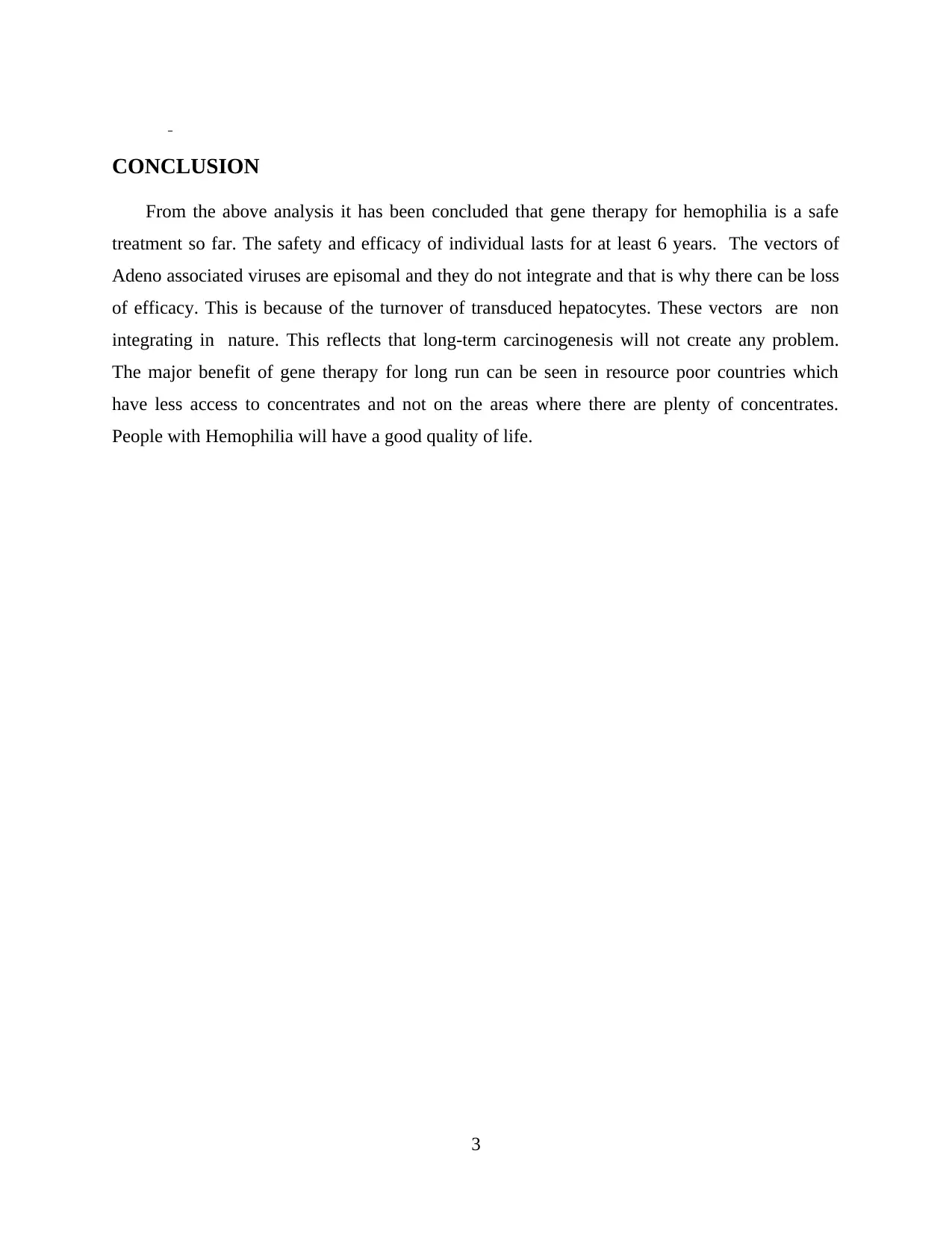
CONCLUSION
From the above analysis it has been concluded that gene therapy for hemophilia is a safe
treatment so far. The safety and efficacy of individual lasts for at least 6 years. The vectors of
Adeno associated viruses are episomal and they do not integrate and that is why there can be loss
of efficacy. This is because of the turnover of transduced hepatocytes. These vectors are non
integrating in nature. This reflects that long-term carcinogenesis will not create any problem.
The major benefit of gene therapy for long run can be seen in resource poor countries which
have less access to concentrates and not on the areas where there are plenty of concentrates.
People with Hemophilia will have a good quality of life.
3
From the above analysis it has been concluded that gene therapy for hemophilia is a safe
treatment so far. The safety and efficacy of individual lasts for at least 6 years. The vectors of
Adeno associated viruses are episomal and they do not integrate and that is why there can be loss
of efficacy. This is because of the turnover of transduced hepatocytes. These vectors are non
integrating in nature. This reflects that long-term carcinogenesis will not create any problem.
The major benefit of gene therapy for long run can be seen in resource poor countries which
have less access to concentrates and not on the areas where there are plenty of concentrates.
People with Hemophilia will have a good quality of life.
3
⊘ This is a preview!⊘
Do you want full access?
Subscribe today to unlock all pages.

Trusted by 1+ million students worldwide
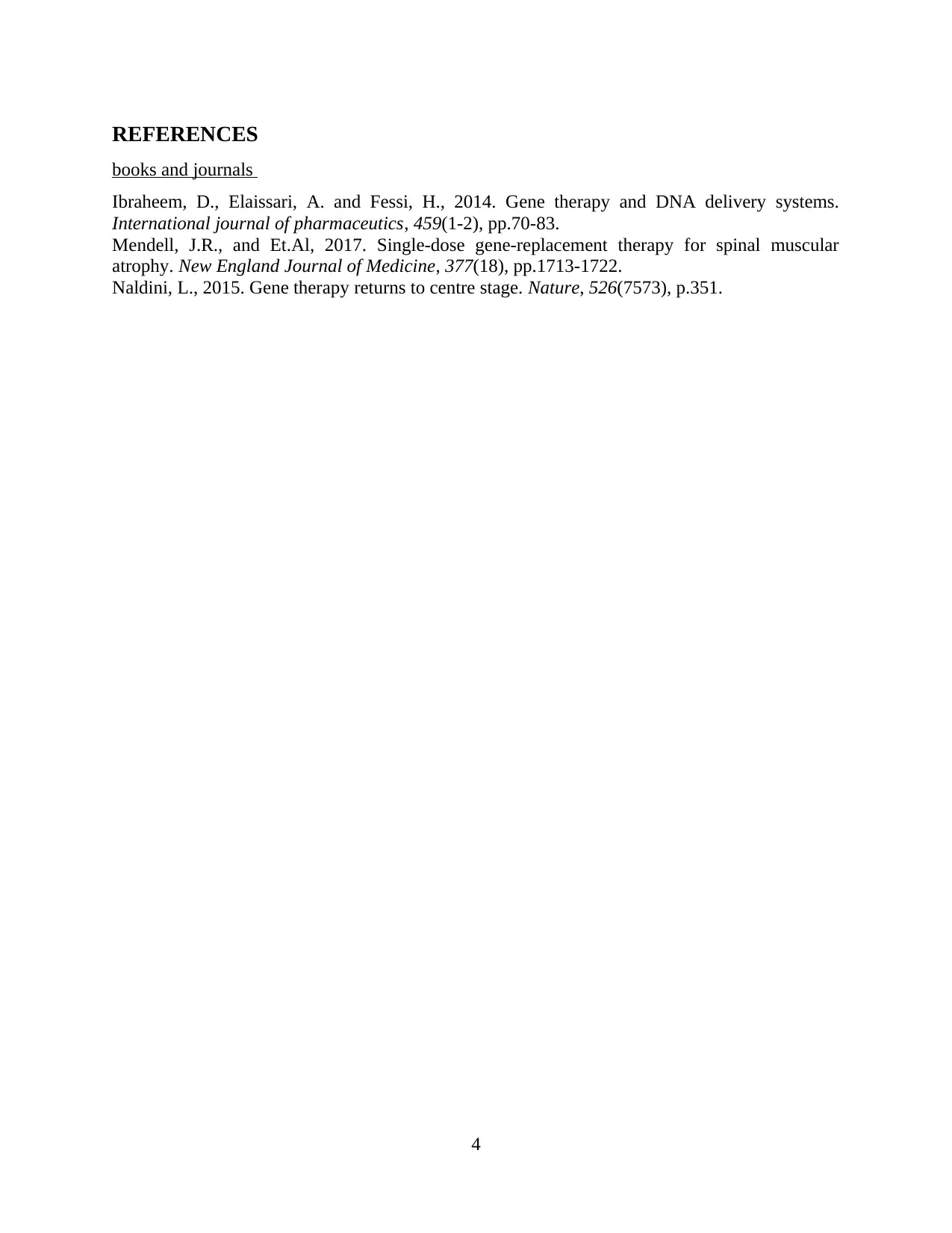
REFERENCES
books and journals
Ibraheem, D., Elaissari, A. and Fessi, H., 2014. Gene therapy and DNA delivery systems.
International journal of pharmaceutics, 459(1-2), pp.70-83.
Mendell, J.R., and Et.Al, 2017. Single-dose gene-replacement therapy for spinal muscular
atrophy. New England Journal of Medicine, 377(18), pp.1713-1722.
Naldini, L., 2015. Gene therapy returns to centre stage. Nature, 526(7573), p.351.
4
books and journals
Ibraheem, D., Elaissari, A. and Fessi, H., 2014. Gene therapy and DNA delivery systems.
International journal of pharmaceutics, 459(1-2), pp.70-83.
Mendell, J.R., and Et.Al, 2017. Single-dose gene-replacement therapy for spinal muscular
atrophy. New England Journal of Medicine, 377(18), pp.1713-1722.
Naldini, L., 2015. Gene therapy returns to centre stage. Nature, 526(7573), p.351.
4
1 out of 7
Related Documents
Your All-in-One AI-Powered Toolkit for Academic Success.
+13062052269
info@desklib.com
Available 24*7 on WhatsApp / Email
![[object Object]](/_next/static/media/star-bottom.7253800d.svg)
Unlock your academic potential
Copyright © 2020–2025 A2Z Services. All Rights Reserved. Developed and managed by ZUCOL.




